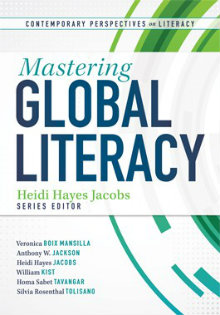Mastering Global Literacy in the Classroom
Mastering Global Literacy
Heidi Hayes Jacobs, Series Editor
(Solution Tree Press, 2014 – Learn more)
 Reviewed by Susan Schwartz
Reviewed by Susan Schwartz
Reading this book only a couple days after the Brexit vote in Great Britain, I couldn’t help but wonder if the result would have been different had more people been familiar with the ideas presented in Mastering Global Literacy. Perhaps now more than ever, it is vital for teachers to help their students . . .
…succeed in this new global age, (by giving them) capacities that include, but go beyond, reading, mathematics, and science; they will need to be far more knowledgeable and curious about world regions and global issues, attuned to diverse perspectives, able to communicate across cultures and in other languages, and disposed to acting toward the common good.” (P. 5)
 The five chapters in Mastering Global Literacy, each written by different authors, present a series of essays about what it means to be a globally competent student in the 21st century. It is not a nuts and bolts type of book, although activities for students are mentioned in each chapter.
The five chapters in Mastering Global Literacy, each written by different authors, present a series of essays about what it means to be a globally competent student in the 21st century. It is not a nuts and bolts type of book, although activities for students are mentioned in each chapter.
Rather, the authors offer definitions of “global literacy” and rationales for why teaching students to be globally competent is important, along with some general ideas on how to accomplish that. While each chapter has a different focus, there is considerable overlap in the concepts presented by multiple authors. As a result, the book feels repetitive in many places.
Educating for Global Competence
Chapter 1, “Educating for Global Competence: Redefining Learning for an Interconnected World,” was, for me, the least interesting chapter. I found the organization confusing and the plethora of in-text citations distracting. The core of the chapter was the analysis of four criteria for being a globally competent student. While the list of four competencies on P. 6 was referred to throughout Mastering Global Literacy and the Framework for Global Competence on P. 15 was a very useful visual, the manner in which the chapter described each competency was not as clear as I think it could have been.
Talking to the World
In Chapter 2, “The Globally Connected Educator: Talking To the World – Not Just About the World,” the author suggested five steps that lead to being an educator who is connected to the world beyond her or his classroom and offers reasons why that is important and examples for accomplishing each step.
The examples given for the first three steps are good but basic, e.g. watch a foreign film; participate in globally oriented conferences (but no list of any is provided); use Skype, Twitter, Google Apps and wikis (and explanations what each one is as if readers have never heard of them before).
The fourth step suggests building your own professional learning network, and helpful ideas on how to do that are provided. I was intrigued by the last step, Amplifying Your Curriculum, which was a new way for me of looking at how to extend student learning; many useful ideas are offered and I enjoyed the descriptions of classroom lessons that were presented. I especially appreciated reading ideas for how art and gym classes can be infused with a global learning component.
Taking the Global and Making It Local
Finally in Chapter 3, “Taking the Global and Making It Local – A Qualitative Study,” the Common Core was mentioned! I had been wondering how, in the time of the CCSS and the prevalence of teaching to the test, teachers were supposed to implement the kinds of lessons and projects the authors of Mastering Global Literacy were calling for. The author of Chapter 3 addressed this by saying that the CCSS has a focus on preparing students to be global citizens, although he doesn’t go into any further detail.
This chapter was much more practical in that it included numerous suggestions for projects that require varying degrees of internet access, so teachers who work in schools where connectivity or easy access to the Web is an issue are not precluded from implementing globally-oriented activities. Using Voki in foreign language classes – which would also work well for English language development lessons – was a suggestion I smiled at because I used Voki to record greetings in some foreign languages on my former ESL website.
This chapter also discussed how teachers can collaborate with each other and some of the challenges to implementing a more globally-focused classroom, which will be useful for teachers who are just beginning to do that.
Growing Up in a Global Classroom
The story that opened Chapter 4, “Growing Up in a Global Classroom,” was fascinating, and the graphic on P. 69, Elements of a Global Classroom, was interesting. Otherwise, however, this chapter consisted of general exhortations on how and why teachers should transform their students into globally-aware, friendship-oriented, collaborative and creative-focused learners.
Some specific ideas were mentioned; one that I especially liked was to use school fundraisers as opportunities for raising awareness of global issues, and some sources of projects were included.
Interdisciplinary Global Issues
In Chapter 5, “Interdisciplinary Global Issues: A Curriculum for the 21st Century Learner,” the author discussed the 18 National Geography Standards and how they relate to becoming a globally competent student. She then discussed designing curriculum, and the list of ten questions on P. 99 will help teachers decide what to include.
The chapter ended with descriptions of eight interdisciplinary units on the following topics: sustainability, global ambassadors, mass media, urban planning, the arts, mindfulness, language instruction, and education in Finland. Each description included ideas, links and examples, which will give teachers a good starting point should they wish to implement similar units with their own students.
Who the Book Is For
Teachers who are just beginning to think about how they can bring the world into their classroom will find that Mastering Global Literacy gives them helpful frameworks for understanding why teaching global competence to students is important – with definitions and reasons to use in support of such teaching along with some examples of activities for students.
But teachers who are looking for a practical manual that is chock-full of ready-to-implement lesson plans, with plenty of resources for elementary, middle and high school students, will only be partially satisfied and will need to look elsewhere for additional ideas.
Regardless of one’s level of comfort teaching global literacy, I think it is important for all teachers to ask themselves:
Can we, as educators, afford to see no relevance in global connections for our students? Can we realistically be satisfied with believing that global connections should be confined to the social studies classroom in elementary school and a geography course or foreign language class here and there in middle and high schools?” (P. 34)
After reading this book, I believe all teachers will agree that the answer is, clearly, no.
The book’s contributors include Veronica Boix Mansilla, Anthony W. Jackson, Heidi Hayes Jacobs, William Kist, Homa Sabet Tavangar, and Silvia Rosenthal Tolisano.
____________________
Susan Schwartz has been a foreign exchange student, Peace Corps Volunteer, and Fulbright-Hays Seminars Abroad participant, and has taught at universities in China and Indonesia. While she was an ESL teacher at a public school in Massachusetts, her students skyped with a teacher in Saudi Arabia and videotaped interviews with adult ESL students about their native countries. Susan (@The_ESL_Nexus) now creates digital education products, co-hosts the monthly #ELLEdTech Twitter chat, and blogs at The ESL Connection.
































